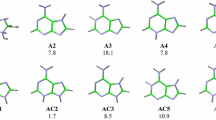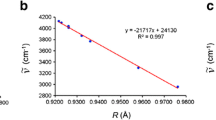Abstract
Due to complexity arising from the presence of various rare tautomers and multiple protonation sites, little is known of the proton-bound heterodimers of guanine (G) and cytosine (C) that may exist in the gas phase. We extensively explored structures and energies of the heterodimers by density functional theory using the B3LYP functional, wherein rare tautomers of G and C that were predicted to be energetically accessible were considered in possible heterodimer structures. This extensive search found more than 90 stable structures for the proton-bound heterodimers, where various types of base-pairings were observed. For the six lowest energy structures that lie within 3 kcal/mol in energy from the most stable structure, ionic hydrogen bonding was found to be involved in base-pairing. The non-covalent complexation energies of the heterodimers were found to be quite strong at 40–50 kcal/mol. Some pairs of the heterodimers were connected by simple proton transfer in the ionic hydrogen bond as well. In addition, a Hoogsteen base pair was predicted to be the most stable conformer in the gas phase with a more than 90% population. Solvent field effects also suggested that the Hoogsteen base pair is one of the most stable conformers in an aqueous environment. Thus, we suggest that the Hoogsteen base pair is the most predominant form of the proton-bound heterodimers of G and C that may exist in the gas phase.






Similar content being viewed by others
References
Egli M, Saenger W (1984) Principles of nucleic acid structure. Springer, New York
Hobza P, Šponer J (1999) Structure, energetics, and dynamics of the nucleic acid base pairs: nonempirical ab initio calculations. Chem Rev 99:3247–3276
Abo-Riziq A, Grace L, Nir E, Kabelac M, Hobza P, de Vries MS (2005) Photochemical selectivity in guanine–cytosine base-pair structures. Proc Natl Acad Sci USA 102:20–23
Francés-Monerris A, Segarra-Martí J, Merchán M, Roca-Sanjuán D (2016) Theoretical study on the excited-state π-stacking versus intermolecular hydrogen-transfer processes in the guanine–cytosine/cytosine trimer. Theor Chem Acc 135:31
Watanabe S, Ogata Y, Kawatsu T, Kawashima Y, Tachikawa M (2015) Effects of monohydration on an adenine–thymine base pair. Theor Chem Acc 134:84
Eizaguirre A, Lamsabhi AM, Mó O, Yáñez M (2011) Assisted intramolecular proton transfer in (uracil)2Ca2+. Theor Chem Acc 128:457–464
Šponer J, Leszczynski J, Vetterl V, Hobza P (1996) Base stacking and hydrogen bonding in protonated cytosine dimer: the role of molecular ion-dipole and induction interactions. J Biomol Struct Dyn 13:695–706
Han SY, Oh HB (2006) Theoretical study of the ionic hydrogen bond in the isolated proton-bound dimer of cytosine. Chem Phys Lett 432:269–274
Han SY, Lee SH, Chung J, Oh HB (2007) Base-pair interactions in the gas-phase proton-bonded complexes of C+ G and C+ GC. J Chem Phys 127:245102–245110
Halder A, Halder S, Bhattacharyya D, Mitra A (2014) Feasibility of occurrence of different types of protonated base pairs in RNA: a quantum chemical study. Phys Chem Chem Phys 16:18383–18396
Day HA, Pavlou P, Waller ZAE (2014) i-Motif DNA: structure, stability and targeting with ligands. Bioorg Medicinal Chem 22:4407–4418
Yang B, Wu RR, Berden G, Oomens J, Rodgers MT (2013) Infrared multiple photon dissociation action spectroscopy of proton-bound dimers of cytosine and modified cytosines: effects of modifications on gas-phase conformations. J Phys Chem B 117:14191–14201
Kwon S, Oh HB, Han SY (2015) Infrared multiple photon depletion of the gas-phase proton-bound cytosine dimer. Chem Lett 44:1756–1758
Yang B, Rodgers MT (2014) Base-pairing energies of proton-bound heterodimers of cytosine and modified cytosines: implications for the stability of DNA i-motif conformations. J Am Chem Soc 136:282–290
Yang B, Moehlig AR, Frieler CE, Rodgers MT (2015) Base-pairing energies of protonated nucleobase pairs and proton affinities of 1-methylated cytosines: model systems for the effects of the sugar moiety on the stability of DNA i-motif conformations. J Phys Chem B 119:1857–1868
Yang B, Rodgers MT (2015) Base-pairing energies of protonated nucleoside base pairs of dCyd and m5dCyd: implications for the stability of DNA i-motif conformations. J Am Soc Mass Spectrom 26:1394–1403
Lieblein AL, Krämer M, Dreuw A, Fürtig B, Schwalbe H (2012) The nature of hydrogen bonds in cytidine H + cytidine DNA base pairs. Angew Chem Int 51:4067–4070
Gehring K, Leroy JL, Gueron M (1993) A tetrameric DNA structure with protonated cytosine–cytosine base pairs. Nature 363:561–565
Landridge L, Rich A (1963) Molecular structure of helical polycytidylic acid. Nature 198:725–728
Rajagopal P, Feigon J (1989) Triple-strand formation in the homopurine:homopyrimidine DNA oligonucleotides d(G-A)4 and d(T-C)4. Nature 339:637–640
Povsic TJ, Dervan PB (1989) Triple helix formation by oligonucleotides on DNA extended to the physiological pH range. J Am Chem Soc 111:3059–3061
Florián J, Baumruk V, Leszczynski J (1996) IR and Raman spectra, tautomeric stabilities, and scaled quantum mechanical force fields of protonated cytosine. J Phys Chem 100:5578–5589
Hunter WN, Brown T, Anand NN, Kennard O (1986) Structure of an adenine-cytosine base pair in DNA and its implications for mismatch repair. Nature 320:552–555
Šponer J, Burda JV, Mejzlik P, Leszczynski J, Hobza P (1997) Hydrogen-bonded trimers of DNA bases and their interaction with metal cations: ab initio quantum-chemical and empirical potential study. J Biomol Struct Dyn 14:613–628
Nonin S, Leroy JL (1996) Structure and conversion kinetics of a bi-stable DNA i-motif: broken symmetry in the [d(5mCCTCC)]4 tetramer. J Mol Biol 261:399–414
Florián J, Leszczynski J (1996) Spontaneous DNA mutations induced by proton transfer in the guanine cytosine base pairs: an energetic perspective. J Am Chem Soc 118:3010–3017
Berger I, Egli M, Rich A (1996) Inter-strand C–H···O hydrogen bonds stabilizing four-stranded intercalated molecules: stereoelectronic effects of O4′ in cytosine-rich DNA. Proc Natl Acad Sci USA 93:12116–12121
Lin Y, Wang H, Gao S, Schaefer HF III (2011) Hydrogen-bonded proton transfer in the protonated guanine-cytosine (GC + H)+ base pair. J Phys Chem B 115:11746–11756
Noguera M, Sodupe M, Bertran J (2004) Effects of protonation on proton-transfer processes in guanine–cytosine Watson–Crick base pairs. Theor Chem Acc 112:318–326
Wang H, Zhang JD, Schaefer HF III (2010) The protonated guanine–cytosine base pair. Chem Phys Chem 11:622–629
Oh HB, Chang L, Hwang HY, Zhai HY, Breuker K, Zabrouskov V, Carpenter BK, McLafferty FW (2005) Infrared photodissociation spectroscopy of electrosprayed ions in a fourier transform mass spectrometer. J Am Chem Soc 127:4076–4083
Eyler JR (2009) Infrared multiple photon dissociation spectroscopy of ions in penning traps. Mass Spectrom Rev 28:448–467
Fridgen TD (2009) Infrared consequence spectroscopy of gaseous protonated and metal ion cationized complexes. Mass Spectrom Rev 28:586–607
Rajabi K, Theel K, Gillis EAL, Beran G, Fridgen TD (2009) The structure of the protonated adenine dimer by infrared multiple photon dissociation spectroscopy and electronic structure calculations. J Phys Chem A 113:8099–8107
Armentrout PB (2002) Mass spectrometry—not just a structural tool: the use of guided ion beam tandem mass spectrometry to determine thermochemistry. J Am Soc Mass Spectrom 13:419–434
Frisch MJ et al (2013) Gaussian 09, revision D0.1. Gaussian Inc., Wallingford
Jurečka P, Šponer J, Černý J, Hobza P (2006) Benchmark database of accurate (MP2 and CCSD(T) complete basis set limit) interaction energies of small model complexes, DNA base pairs, and amino acid pairs. Phys Chem Chem Phys 8:1985–1993
Mejía-Mazariegos L, Robles J, García-Revilla MA (2016) Tautomerism in some pyrimidine nucleoside analogues used in the treatment of cancer: an ab initio study. Theor Chem Acc 135:233
Boys SF, Bernardi F (1970) The calculation of small molecular interactions by the differences of separate total energies. Some procedures with reduced errors. Mol Phys 19:553–566
Tomasi J, Mennucci B, Cammi R (2005) Quantum mechanical continuum solvation models. Chem Rev 105:2999–3094
Liang W, Haoran L, Hu X, Han S (2006) Systematic theoretical investigations on all of the tautomers of guanine: from both dynamics and thermodynamics viewpoint. Chem Phys 328:93–102
Choi MY, Miller RE (2006) Four tautomers of isolated guanine from infrared laser spectroscopy in helium nanodroplets. J Am Chem Soc 128:7320–7328
Mons M, Dimicoli I, Piuzzi F, Tardivel B, Elhanine M (2002) Tautomerism of the DNA base guanine and its methylated derivatives as studied by gas-phase infrared and ultraviolet spectroscopy. J Phys Chem A 106:5088–5094
Nir E, Janzen C, Imhof P, Kleinermanns K, de Vries MS (2001) Guanine tautomerism revealed by UV–UV and IR–UV hole burning spectroscopy. J Chem Phys 115:4604–4611
Bazso G, Tarczay G, Fogarasi G, Szalay PG (2011) Tautomers of cytosine and their excited electronic states: a matrix isolation spectroscopic and quantum chemical study. Phys Chem Chem Phys 13:6799–6807
Burova TG, Ermolenkov VV, Galina NT, Kadrov DM, Nurlygaianova MN, Baranov VI, Lednev IK (2013) Ionic and tautomeric composition of cytosine in aqueous solution: resonance and non-resonance Raman spectroscopy study. J Phys Chem A 117:12734–12748
Brown RD, Godfrey PD, McNaughton D, Pierlot AP (1989) Tautomers of cytosine by microwave spectroscopy. J Am Chem Soc 111:2308–2310
Choi MY, Dong F, Miller RE (2005) Multiple tautomers of cytosine identified and characterized by infrared laser spectroscopy in Helium nanodroplets: probing structure using vibrational transition moment angles. Phil Trans R Soc A 363:393
Colominas C, Luque FJ, Orozco M (1996) Tautomerism and protonation of guanine and cytosine. Implications in the formation of hydrogen-bonded complexes. J Am Chem Soc 118:6811–6821
Forde G, Gorb L, Shiskin O, Flood A, Hubbard C, Hill G, Leszczynski J (2003) Molecular structure and properties of protonated and methylated derivatives of cytosine. J Biomol Struct Dyn 20:819–828
Russo N, Toscano M, Grand A, Jolibois F (1998) Protonation of thymine, cytosine, adenine, and guanine DNA nucleic acid bases: theoretical investigation into the framework of density functional theory. J Comput Chem 19:989–1000
Bakker JM, Salpin JY, Maitre P (2009) Tautomerism of cytosine probed by gas phase IR spectroscopy. Int J Mass Spectrom 283:214–221
Hoogsteen K (1963) The crystal and molecular structure of a hydrogen-bonded complex between 1-methylthymine and 9-methyladenine. Acta Crystallogr 16:907–916
Aishima J, Gitti RK, Noah JE, Gan HH, Schlick T, Wolberger C (2002) A Hoogsteen base pair embedded in undistorted B-DNA. Nucl Acids Res 30:5244–5252
Nikolova EN, Kim E, Wise AA, O’Brien PJ, Andricioaei I, Al-Hashimi HM (2011) Transient Hoogsteen base pairs in canonical duplex DNA. Nature 470:498–502
Acknowledgements
This work was supported by NRF (2016R1D1A1B03931987). This work was also supported by KBSI under the R&D program (Project No. D37613) supervised by MSIP.
Author information
Authors and Affiliations
Corresponding author
Electronic supplementary material
Below is the link to the electronic supplementary material.
214_2017_2165_MOESM1_ESM.docx
The 58 lowest energy structures predicted for the proton-bound heterodimers with the predicted energies (ΔE 0 and ΔG) of up to 20 kcal/mol at the theory level of B3LYP/6-31 + G(d,p). Predicted harmonic vibrational frequencies (> 1600 cm−1) and the Cartesian coordinates for the conformers of 1 to 6 at the theory levels of B3LYP/6-31 + G(d,p) and MP2/cc-aug-pVDZ (DOCX 1138 kb)
Rights and permissions
About this article
Cite this article
Jun, J., Han, S.Y. Theoretical exploration of gas-phase conformers of proton-bound non-covalent heterodimers of guanine and cytosine rare tautomers: structures and energies. Theor Chem Acc 136, 136 (2017). https://doi.org/10.1007/s00214-017-2165-0
Received:
Accepted:
Published:
DOI: https://doi.org/10.1007/s00214-017-2165-0




